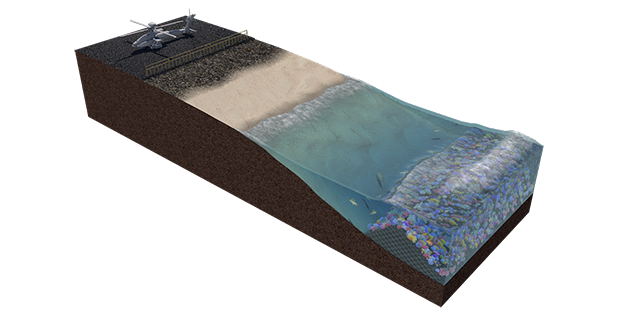 |
| Military bases could be protected by artificial reefs. DARPA is the Defense Advanced Research Projects Agency. |
US Army funds research to develop 'Reefense' structures that rapidly recruit shellfish and corals to defend against storm surges.
In the face of rising seas and climate change, the US military wants to construct artificial reefs to protect coastal bases from storm surges. The Reefense Program was awarded three contracts with the goal of using artificial and natural defenses to enhance the protection provided by man-built seawalls and concrete breakwaters alone.
The project comes after catastrophic incidents like Hurricane Michael, a Category 5 storm that destroyed every building at Tyndall Air Force Base in Florida and struck some very expensive F-22 Raptor fighter jets in 2018, resulting in $4.7 billion in losses overall.
"We're here to develop self-healing, bio-engineered hybrid structures to simulate coral reefs that mitigate flooding and coastal erosion, but also have a living component," says Cathrine Campbell of the US Defense Advanced Research Projects Agency (DARPA). ).
The first line of defense that DARPA's Reefense program envisions consists of an artificial structure capable of dissipating some of the force of incoming waves and storm surges. This would pave the way for oysters or corals to grow on an artificial basis and further enhance coastal protection capabilities.
While natural reefs typically begin to form over a period of five to ten years, DARPA aims to have these artificial reef structures stimulate the settlement of oysters and corals within just a few years. Her insights could benefit from new laboratory techniques for cultivating shellfish and corals.
As part of the program, one team at Rutgers University in New Jersey received $4.5 million to develop defenses based on oyster reefs in the Gulf of Mexico near Tyndale Air Force Base. Another team at the University of Hawaii received more than $7.3 million to experiment with structures that encourage coral growth in the Pacific Ocean. The third team, the University of Miami, was awarded nearly $7.5 million to develop an artificial reef solution with different types of Atlantic reefs.
Research teams must first build an artificial reef, starting at 50 meters, before eventually extending to 150 meters. Early testing in wave tanks is slated to eventually lead to a three-year overseas deployment between 2023 and 2026.
The researchers will also selectively breed shellfish and corals in seawater temperatures 3°C higher than ambient temperatures, so the animals could better survive in an increasingly warming world.
"All teams have experience growing shellfish and corals in their own laboratory environments, choosing higher temperatures or disease resistance," Campbell says.
